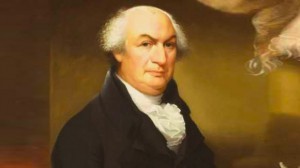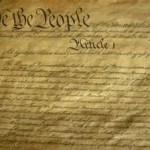 There were many luminaries at the 1787 Constitutional Convention. Washington, Franklin et al. Often overlooked is the Preamble’s author, Gouverneur Morris.
There were many luminaries at the 1787 Constitutional Convention. Washington, Franklin et al. Often overlooked is the Preamble’s author, Gouverneur Morris.
The Constitution’s Preamble has stood as the mission statement of the United States since the Constitution was made public and sent to the states for ratification in September, 1787. Nearly every American student has spent time memorizing the Preamble. The opening three words: “We the People” have provided the inspiration for the growing inclusiveness in the American body politic for over two centuries.
The Preamble: Mission Statement of the United States of America
It is the mission statement that has given Americans and people around the world the hope of a free and just society. The Preamble reads:
“We the People of the United States, in Order to form a more perfect Union, establish Justice, insure domestic Tranquility, provide for the common defense, promote the general Welfare, and secure the Blessings of Liberty to ourselves and our Posterity, do ordain and establish this Constitution for the United States of America.”
A Statement of Duty, Responsibility and Obligation
Beyond being a mission statement that simply states goals, the Preamble lays out the fiduciary obligations of the United States government as an agent of the American people. The Preamble designates the People as the creators of the United States, and the United States as that creation has an obligation of loyalty to the People and a duty to follow the People’s instructions.
Constitutional Convention: Four Months Twenty-Three Articles
The Constitutional Convention was called to order by George Washington on May 25, 1787 in Philadelphia.
From then until September 8th the delegates labored to mold a national government that reconciled the needs of all the states and the national philosophy of the Declaration of Independence. These labors resulted in a document with 23 articles that had been amended multiple times since its presentation to the Convention by the Committee on Detail. These 23 articles had amendments and were not organized in a coherent fashion.
The Constitution’s Committee on Style and Arrangement: Four Days, Seven Articles
On September 8th The Committee on Style and Arrangement was created. This committee was given the task of distilling the Convention’s work. The Style Committee consisted of:
- Alexander Hamilton (NY)
- William Johnson (CT)
- Rufus King (MA)
- James Madison (VA)
- Gouverneur Morris (PA)
In four short days, this committee took the 23 articles and amendments and distilled them into the seven articles that make up the original Constitution and put together the organization that consolidated the diverse subject matter into a logical and cohesive order:
- Article I, The Legislative Branch
- Article II, The Executive Branch
- Article III, The Judiciary
- Article IV, The States
- Article V, The Amendment Process
- Article VI, The Legal Status of the Constitution
- Article VII, Ratification
Only a Single Technical Amendment to the work of Gouverneur Morris
In the end the work was completed in less than three days. The committee was appointed on the eighth and the Constitution was presented to the Convention on the twelfth. The ultimate document is credited to the pen of a single man, Gouverneur Morris. To the Constitution presented by Morris, there was but a single amendment. It changed the number of people represented by a congressman from 40,000 to 30,000. This was the only constitutional change to which George Washington lent his considerable prestige.
This final draft and organization is credited to Gouverneur Morris (not a governor, this was his name), by no less an authority than James Madison:
“The finish given to the style and arrangement of the Constitution fairly belongs to the pen of Mr. Morris.”
Gouverneur Morris: Author of “We the People”
 Gouverneur Morris was a New York native. Morris enrolled at King’s College, the future Columbia University, in 1764 when he was only 12. He graduated at 16 and received a master’s degree 19. On May 8, 1775 he was elected to represent his family estate in what is now Bronx County as a member of the New York Provincial Congress. While a member of the congress, he advocated turning New York into an independent state. This advocacy of independence was at odds with the loyalties of his family.
Gouverneur Morris was a New York native. Morris enrolled at King’s College, the future Columbia University, in 1764 when he was only 12. He graduated at 16 and received a master’s degree 19. On May 8, 1775 he was elected to represent his family estate in what is now Bronx County as a member of the New York Provincial Congress. While a member of the congress, he advocated turning New York into an independent state. This advocacy of independence was at odds with the loyalties of his family.
In May 1776 he was chosen to coordinate New York’s defense measures with George Washington’s main army and the Continental Congress. In August 1776, the British seized New York City and his family’s estate. His mother, a British loyalist, assisted the British by giving them the estate for military use. After his mother’s actions he was no longer eligible for membership in the New York state legislature. He was appointed to be a delegate to the Continental Congress.
In 1778 Morris was a signer of the Articles of Confederation. In 1779, he lost re-election to Congress. He moved to Philadelphia and worked as a lawyer and merchant. At age twenty-eight, Morris’s left leg was shattered and replaced with a wooden peg leg. In 1787 he was recommended as a delegate to the Constitutional Convention by no less than George Washington. At the convention he gave more speeches than any other delegate, a total of 173.
From the “people of the States” to the “People of the United States”
The phrase which every American has come to know and rely upon, as expressing the aspirations of people everywhere, is the work of Gouverneur Morris. When he set about the work with the Committee on Style, the opening phrase was:
“We the people of the States of New Hampshire, Massachusetts ….”
Morris changed it to:
“We the People of the United States….”
Before the change by Gouverneur Morris, the nature of the entity being created in Philadelphia was a group of governments organizing together. Morris’ words made the entity a single nation, the United States of America. [1]
Leer entrada en Espanol: Nosotros el Pueblo: Gouverneur Morris & el Preámbulo de la Constitución de EU Parte 1 y
[1] Morris’ contributions to the Revolution and the early days of the United States went well beyond writing “We the People. For more on Morris’ life and contributions see GOUVERNEUR MORRIS, Pennsylvania.






[…] Morris set forth the purposes of this nation in the Preamble, with perhaps the three most memorable words in United States history: “We the […]